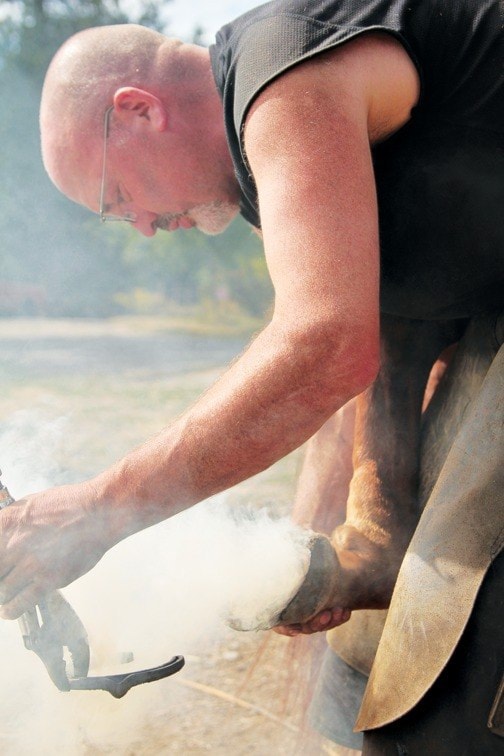Shane Sampson swore he would never shoe horses for a living. His father was a farrier and Sampson knew how much hard work was involved and the pitfalls of the trade.
“My dad was a horseshoer and I watch him get knocked around,” Sampson said. “He never seemed to be rich and I always figured I wouldn’t. Then I went off and worked in a mill for a bit and all I wanted to do was shoe horses.”
Sampson, 46, first started shoeing horses when he was 15 at a dude ranch in the B.C. Interior.
“I started nailing them on there,” he said. “I have a cousin that shoes too.”
He has been shoeing horses full-time for 10 years now. He doesn’t have an official company name.
“I’m Shane Sampson,” he said. “That’s who I want the cheques made out to.”
Sampson heats pre-made mild steel shoes in a propane forge in the back of his Dodge pickup, pounds them with a hammer and anvil to tailor the shape to the horse’s hoof, eyeballs the adjustment and presses the hot shoe onto the horse’s hoof.
The heated hoof sends out clouds of white smoke that smells like burning hair. Chip, the quarter horse being shoed, is relaxed and pretty much indifferent to the whole affair. The scorch marks left on the shoe show Sampson where the shoe is not making full contact with the hoof and he forms the shoe until there is even contact with the hoof.
It takes about 90 minutes to shoe one horse.
Chip’s owner Lisa Walker said some horses like being shoed.
“It’s like a manicure to them,” Walker said.
“Especially a horse that’s worked lots,” Sampson added. “They know the difference between being pulled out to go to work and being pulled out just to stand and get their feet done.”
People have been shoeing horses for thousands of years to protect their horses’ hooves.
“The Egyptians put woven sandals on horses and they knew how many sandals it would take to get from point A to point B,” Sampson said. “I think the first steel shoes were found from centuries ago in China. They put steel shoes on in the U.K. back when it was more expensive than gold.”
There are almost as many different types of shoes for horses as there are for people.
Shoes protect the horse’s hooves from wear, but materials vary depending on needs. Plastic, rubber, aluminum, glass fibre, and other materials are used for specific applications. There are even orthopedic horse shoes for horses with foot problems. Sampson has most of them in his truck.
Blacksmithing is only one part of the farrier’s trade. A good farrier must be able to work alongside veterinarians and horse owners and, above all, be able to understand and get along with horses.
“Not everybody can get along with the horses,” Sampson said. “Some places it’s not a matter of getting along with the horse or shoeing the horse, it’s just dealing with the owners.”
Shoeing is hard work and there is risk of injury. Sampson’s had broken toes from horses accidentally stepping on his feet and gets burns from his forge.
“I’ve been kicked and things like that, but never really hospitalized,” he said. “They’re all different. They all have different personalities.”
Sampson said one of the perks of being a farrier is that he’s home every night, which is important since he has two young children.
How has the business changed over the years?
“There’s a better selection of nails,” he said. “That’s the biggest thing, I think, and there’s some really good education now. You’re not just left to yourself. We have clinics we can go to in B.C., especially on the Lower Mainland and Island, that are world class. Canada doesn’t take a back seat to the States and other places when it comes to shoeing horses.”
photos@nanaimobulletin.com
